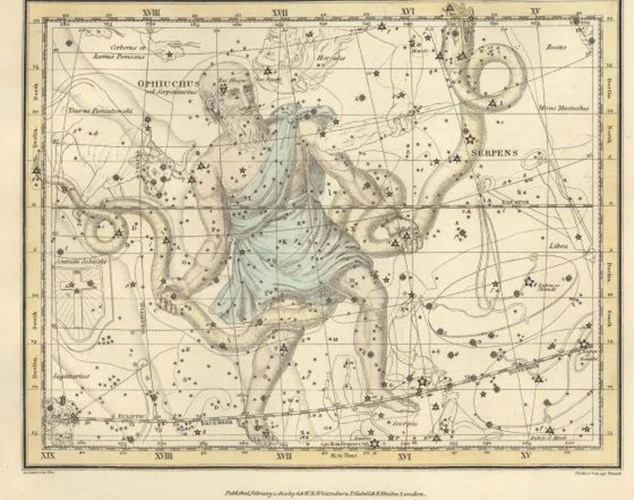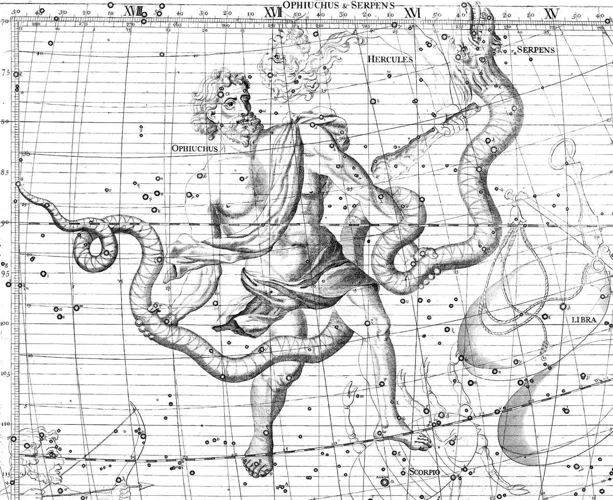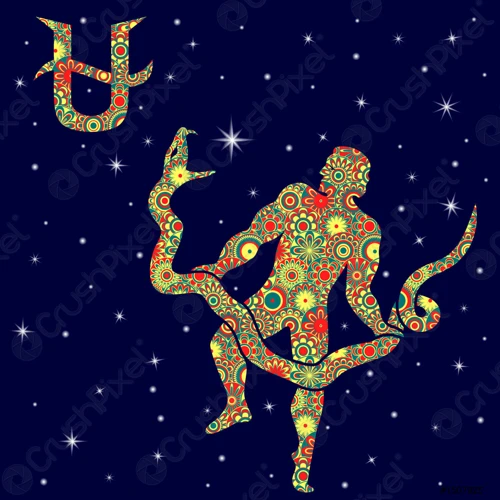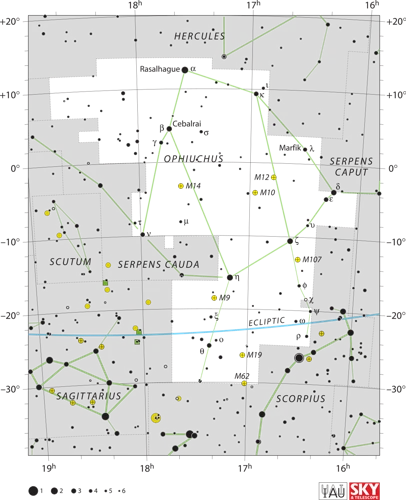The enigmatic figure of Ophiuchus has long captivated astronomers and enthusiasts alike, unveiling a rich history steeped in mythology and astronomical records. This celestial serpent-bearer is not widely known to the general public, overshadowed by the more familiar zodiac signs. However, delving into the deep recesses of ancient texts and modern observations, one can uncover a compelling narrative surrounding Ophiuchus. From its ancient origins in mythological tales to its depiction in Ptolemy’s Almagest, and even its controversial inclusion as the 13th zodiac sign, Ophiuchus has left an indelible mark on the annals of astronomy. Join us on a journey as we decipher the hidden secrets and unravel the enigmatic past of Ophiuchus in astronomical history.
Contents
- The Mythology of Ophiuchus
- Ophiuchus in Ancient Astronomical Texts
- Rediscovering Ophiuchus: Modern Observations
- Ophiuchus in Ptolemy’s Almagest
- Historical Depictions of Ophiuchus
- The Ophiuchus Zodiac Controversy
- Ophiuchus in Indigenous Astronomical Systems
- Conclusion
- Frequently Asked Questions
- References
-
Frequently Asked Questions
- 1. What is the origin of the name “Ophiuchus”?
- 2. Is Ophiuchus considered a zodiac sign?
- 3. Can Ophiuchus be seen in the night sky?
- 4. What is the mythology behind Ophiuchus?
- 5. When was Ophiuchus first mentioned in astronomical records?
- 6. How does Ophiuchus differ from other constellations?
- 7. What are some famous artworks that depict Ophiuchus?
- 8. What is the controversy surrounding Ophiuchus as the 13th zodiac sign?
- 9. How is Ophiuchus viewed in Chinese astronomy?
- 10. What is the significance of Ophiuchus in Mesopotamian astronomy?
- References
- Read More
The Mythology of Ophiuchus
In the realm of mythology, Ophiuchus plays a significant role as the serpent-bearer. The origins of this mythological figure can be traced back to ancient Greek mythology, where Ophiuchus is associated with the legendary healer and physician, Asclepius. As the son of Apollo, Asclepius possessed incredible healing abilities and was known to have raised the dead. However, his exceptional powers drew the attention of the gods, and Zeus ultimately struck him down with a lightning bolt. In a gesture of honor, Zeus immortalized Asclepius in the night sky as the constellation Ophiuchus.
In other mythological traditions, Ophiuchus is linked to various fascinating stories. In Mayan mythology, for example, Ophiuchus is perceived as a representation of the celestial counterpart of Hunahpu, one of the Hero Twins who descended into the underworld. This cosmic embodiment is believed to bring balance and healing energies into the world, symbolizing the intertwined relationship between celestial bodies and earthly realms.
Ophiuchus’ connection to serpents in mythology extends beyond the Greek and Mayan traditions. In ancient Egyptian mythology, Ophiuchus is linked to the deity Imhotep, known as the god of medicine and healing. Imhotep, often depicted with a serpent intertwined around a staff, shares similarities with Asclepius, highlighting the common thread of healing and wisdom associated with this constellation.
These mythical tales and cross-cultural connections offer a glimpse into the significance and symbolism surrounding Ophiuchus. As we delve further into the historical records and astronomical depictions, we can unravel more about the intriguing mythology that underpins this celestial figure.
Ophiuchus in Ancient Astronomical Texts
Ophiuchus holds a prominent place in ancient astronomical texts, providing valuable insights into its significance. One of the earliest references to Ophiuchus can be found in the famous astronomical work known as the Almagest, written by the Greek astronomer Ptolemy in the 2nd century CE. In the Almagest, Ophiuchus is recognized as one of the 48 constellations cataloged by Ptolemy. Within this extensive catalog, Ophiuchus is positioned near the celestial equator, straddling the equatorial region between Hercules and Scorpius.
Ptolemy’s depiction of Ophiuchus in the Almagest includes several key stars that define the constellation. The brightest star, known as Rasalhague or Alpha Ophiuchi, shines prominently within Ophiuchus. Other notable stars within the constellation include Sabik (Eta Ophiuchi) and Cebalrai (Beta Ophiuchi). The inclusion of Ophiuchus alongside the other constellations in the Almagest reveals its perceived celestial significance in Ptolemy’s time.
Additionally, Ophiuchus is mentioned in other ancient astronomical texts, such as the Babylonian star catalogs. These texts, dating back to around the 8th century BCE, provide further evidence of the recognition of Ophiuchus in ancient astronomy. The Babylonian astronomers referred to Ophiuchus as MUL.APIN, and it was associated with the god Enki, who was believed to have control over the arts of healing and magic.
These ancient astronomical texts serve as valuable historical records, shedding light on the role and importance of Ophiuchus in early civilizations’ understanding of the celestial realm. As we continue to explore the depths of astronomical knowledge passed down through generations, we gain a deeper appreciation for the enduring presence of Ophiuchus in the annals of ancient astronomy.
Rediscovering Ophiuchus: Modern Observations
Modern observations have played a pivotal role in rediscovering the celestial wonders of Ophiuchus. With advancements in astronomical technology, astronomers have been able to explore and document the intricate details of this intriguing constellation. One notable aspect of modern observations is the identification of several deep sky objects within Ophiuchus, which have provided invaluable insights into the composition and nature of this region of space.
Among the notable deep sky objects within Ophiuchus is the Barnard’s Star, a nearby red dwarf star known for its high proper motion. Located just 6 light-years away from Earth, this star has been extensively studied due to its proximity, allowing researchers to gain a deeper understanding of stellar evolution and dynamics.
Another fascinating feature within Ophiuchus is the globular cluster M14. Composed of thousands of tightly packed stars, globular clusters like M14 offer valuable clues about the formation and age of galaxies. These dense clusters serve as “time capsules,” providing astronomers with a glimpse into the early stages of the universe’s evolution.
Additionally, Ophiuchus is home to several intriguing nebulae, such as the Pipe Nebula and the Snake Nebula. These vast clouds of gas and dust not only exhibit breathtaking beauty but also serve as the birthplace of new stars and planetary systems. Detailed observations of these nebulae allow astronomers to study the processes involved in stellar birth and the formation of planetary systems, shedding light on the origins of life-sustaining environments.
As astronomers continue to explore and analyze the mysteries hidden within Ophiuchus, each observation brings us closer to unraveling the secrets of the universe. The interplay between mythological narratives and modern scientific discoveries allows for a deeper appreciation of the celestial wonders that Ophiuchus holds. Together, these efforts contribute to expanding our knowledge of the cosmos and our place within it. Through continued exploration, Ophiuchus remains a fascinating subject for astronomers and enthusiasts alike.
Ophiuchus in Ptolemy’s Almagest

Ophiuchus holds a prominent place in Ptolemy’s Almagest, a monumental astronomical treatise from the 2nd century AD. Ptolemy, a Greek astronomer and mathematician, categorized celestial objects into various constellations, with Ophiuchus being one of them. Within Almagest, Ophiuchus is identified as a zodiacal constellation located between Scorpius and Sagittarius.
In Ptolemy’s classification, Ophiuchus is described as a noteworthy constellation due to its size and position. The constellation spans a large area of the sky, forming an impressive figure often portrayed as a man holding a serpent. Ptolemy assigned a series of stars to outline the shape of Ophiuchus, including the bright star Rasalhague, which marks the head of the serpent-bearer.
Interestingly, Ptolemy’s depiction of Ophiuchus does not include the animal symbols that characterize the other zodiac constellations. Instead, he presents Ophiuchus as a distinctive human figure, suggesting its unique status within the zodiacal system. This differentiation further emphasizes the significance of Ophiuchus as a separate entity in ancient astronomical records.
While Ptolemy’s Almagest provides valuable insights into the classification and positioning of celestial objects, it is important to note that Ophiuchus’ inclusion in this text does not guarantee its recognition in all ancient astronomical records. The constellation’s significance varies across different cultures and historical periods. By examining the depictions and interpretations of Ophiuchus in artworks, manuscripts, and indigenous astronomical systems, we can gain a more comprehensive understanding of its place in astronomical history.
The 48 Constellations of Ptolemy
Ptolemy, the renowned Greek astronomer of the 2nd century AD, is famous for his work on cataloging and documenting celestial bodies. In his influential work called the “Almagest,” Ptolemy identified and listed a total of 48 constellations observed in the night sky during his time. These constellations formed the foundation of Western astronomy for centuries to come.
Ptolemy’s 48 constellations encompassed a wide range of mythological figures, animals, and objects. They were divided into three categories: the northern constellations, the zodiac constellations, and the southern constellations. The northern constellations included well-known figures such as Ursa Major, Draco, and Cassiopeia. The zodiac constellations, which held great significance in astrology, included familiar names like Leo, Virgo, and Gemini. And the southern constellations presented less familiar figures like Phoenix, Tucana, and Pavo.
Each constellation held its own significance and story, often rooted in mythology and cultural beliefs. Ptolemy’s cataloging efforts aimed to provide a comprehensive and organized understanding of the night sky. His work laid the groundwork for subsequent astronomers and contributed to the development of constellation maps that are still referenced today.
It is worth noting that while Ptolemy’s 48 constellations formed the basis of Western astronomy, different cultures and civilizations had their own unique constellations and star maps. These variations add depth and diversity to our understanding of the night sky, highlighting the rich tapestry of human interpretation and connection to the stars. As we explore the constellations, we gain a deeper appreciation for the intricate relationship between celestial bodies and the human experience of the cosmos.
Noteworthy Features of Ophiuchus in Almagest
Ptolemy’s influential work, the Almagest, provides valuable insights into the features and characteristics of Ophiuchus as observed in ancient astronomical texts. Within the Almagest, Ophiuchus is positioned between the constellations Serpens and Hercules, depicting the serpent-bearer in a dynamic and distinct manner. One noteworthy feature of Ophiuchus in Almagest is its association with the bright star Rasalhague, also known as Alpha Ophiuchi. This prominent star shines brightly in the night sky and is a defining feature of the constellation. It is fascinating to observe how Ptolemy meticulously included Ophiuchus as one of the 48 constellations in the Almagest, highlighting its significance in the celestial panorama. Through Ptolemy’s work, we gain a deeper understanding of the portrayal of Ophiuchus and its role within the ancient astronomical framework. To explore more about the astronomical significance of Ophiuchus and its relation to other celestial phenomena, such as planetary alignments or meteor showers, refer to relevant articles like “Exploring the Science of Planetary Alignments” or “The Origins and Composition of Meteor Showers.”
Historical Depictions of Ophiuchus

Historical depictions of Ophiuchus can be found in various artworks and manuscripts across different cultures and time periods. These visual representations offer valuable insights into the perception and significance attributed to this celestial figure.
Artworks and manuscripts depicting Ophiuchus often showcase the serpent-bearer in different contexts and styles. In ancient Greek art, Ophiuchus is depicted as a man holding a serpent, reflecting the mythological connection to Asclepius and his healing powers. This portrayal emphasizes the connection between wisdom, healing, and the celestial realm.
In Mayan art, Ophiuchus is represented in relation to the underworld. For example, in the Mayan Dresden Codex, a pre-Columbian Mayan manuscript, Ophiuchus is depicted in scenes related to the Ophiuchus God, who guards the entrance to the nine levels of the Mayan underworld (Xibalba). These depictions often feature Ophiuchus in symbolic association with other mythical beings in the Mayan underworld, further highlighting its role in Mayan cosmology and beliefs.
Symbolism surrounding Ophiuchus can also be observed in other cultural depictions. In Egyptian art, Ophiuchus is linked to Imhotep, depicted with a serpent on his staff, representing the healing and wisdom aspects associated with this constellation. In other artistic representations across different cultures, Ophiuchus is often portrayed with serpents coiled around him, symbolizing the intricate connection between the heavens and earthly realms.
Through these visual depictions, we gain a deeper understanding of the historical and cultural significance of Ophiuchus. The artistic interpretations provide a visual link between mythology, cosmology, and the depiction of constellations, enriching our understanding of the celestial serpent-bearer.
Artworks and Manuscripts Depicting Ophiuchus
Throughout history, Ophiuchus has been depicted in various artworks and manuscripts, showcasing its significance and cultural influence. In ancient Greek art, Ophiuchus is often portrayed as a muscular figure clad in a robe, holding a staff with a serpent coiled around it. This imagery symbolizes the healing powers attributed to Ophiuchus and its association with the famed healer Asclepius. These depictions can be found on ancient Greek pottery, mosaics, and sculptures, serving as a visual representation of the mythological tales.
In Mayan manuscripts and codices, Ophiuchus also finds its place among the intricate illustrations. The Mayan civilization holds a deep reverence for celestial bodies and their connections to the earthly realm. Ophiuchus, associated with the celestial counterpart of the Hero Twin Hunahpu in Mayan mythology, is depicted in the artwork as a figure intertwined with serpents, showcasing its role as a cosmic healer and guardian of balance between worlds. These manuscripts provide valuable insights into the Mayan perception of Ophiuchus and its symbolic significance in their cosmology.
Similarly, Ophiuchus is featured in various medieval manuscripts, particularly those related to astrology and astronomy. In these illustrations, the constellation is often presented as a central figure surrounded by other zodiac signs, emphasizing its importance within the celestial sphere. These manuscripts serve as important historical records, capturing the collective knowledge and beliefs about Ophiuchus during that era.
The depiction of Ophiuchus in artworks and manuscripts not only showcases its mythical connections but also highlights its cultural influence across different civilizations. These visual representations provide us with glimpses into how Ophiuchus was perceived and revered throughout history, emphasizing its role as a celestial figure of healing, wisdom, and cosmic balance.
Symbolism and Representations of Ophiuchus
Symbolism surrounding Ophiuchus is woven into various cultural and artistic representations. One of the most prominent symbols associated with Ophiuchus is the serpent, which serves as a central motif in many depictions. The serpent is often intertwined around a staff, representing the celestial serpent-bearer’s role as a healer and guardian of knowledge. This imagery draws connections to the healing abilities of Asclepius in Greek mythology and to the serpent symbolism found in different mythological and spiritual traditions.
In Mayan culture, Ophiuchus finds its place in the mythical beings of the underworld, known as the Nine Lords of Night. These deities are associated with different celestial bodies, and Ophiuchus represents one of the powerful entities overseeing the forces of the Mayan underworld. The representation of Ophiuchus as a deity in Mayan mythology underscores the significance of this constellation in Mesoamerican cultures.
Artistic depictions of Ophiuchus can be found in ancient manuscripts, paintings, and sculptures. In these artworks, Ophiuchus is often portrayed as an individual grasping a serpent or engaged in a healing gesture, highlighting the constellation’s connection to medicine and wisdom. The imagery surrounding Ophiuchus reflects the broader significance of the constellation in the collective consciousness and its exploration of themes such as healing, knowledge, and the interplay between celestial and earthly realms.
In addition to the serpent symbolism, Ophiuchus is also associated with the element of water, further accentuating its healing and transformative qualities. The water element is commonly represented in artistic renditions of Ophiuchus through the presence of flowing rivers, water vessels, or aquatic creatures.
By exploring the symbolism and representations of Ophiuchus, we gain a deeper understanding of the cultural and mythological significance attributed to this celestial serpent-bearer. These various symbolisms and depictions provide a glimpse into the multifaceted nature of Ophiuchus and its connection to themes of healing, knowledge, and the interplay between the celestial and the earthly realms.
The Ophiuchus Zodiac Controversy

The Ophiuchus Zodiac Controversy has stirred up intense debates and discussions among astrology enthusiasts and experts. Traditionally, the zodiac system consists of 12 signs, with each sign representing distinct characteristics and personality traits. However, the introduction of Ophiuchus as the 13th zodiac sign has challenged the long-standing framework.
The controversy surrounding Ophiuchus as a zodiac sign stems from the inclusion of this constellation in the path of the sun. According to astronomers, the Earth’s wobble on its axis known as precession has gradually caused a shift in the alignment of constellations over the centuries. This means that the sun passes through Ophiuchus for a portion of time, along with the other 12 traditional zodiac signs.
Astrologers, on the other hand, argue that the zodiac system is based on the tropical zodiac, which is tied to the seasons and the solstices and equinoxes. In this system, the zodiac signs are not dependent on the actual constellations but rather the divisions of the ecliptic. As a result, Ophiuchus is not recognized as a zodiac sign in this astrological framework.
The introduction of Ophiuchus as the 13th zodiac sign has caused a stir among those who follow astrology closely. Some proponents argue that individuals born under the Ophiuchus sign should be recognized for their distinct qualities and character traits. Others, however, express concern that the inclusion of a new zodiac sign could disrupt the established astrological systems and interpretations.
While the controversy surrounding Ophiuchus continues, it is important to note that the decision to recognize or dismiss it as a zodiac sign ultimately lies in individual interpretations and beliefs. Whether Ophiuchus remains a fringe addition to the zodiac or gains wider acceptance is a topic of ongoing discussion in astrology circles.
The Introduction of Ophiuchus as the 13th Zodiac Sign
The introduction of Ophiuchus as the 13th zodiac sign caused quite a stir among astrologers and enthusiasts. This controversial addition to the zodiac came about in recent times and challenged the traditional astrological framework. Ophiuchus’s inclusion was based on the alignment of the sun with the constellation during specific dates, resulting in a shift towards a 13-sign zodiac system.
Proponents of this new zodiac argue that Ophiuchus brings new dimensions and characteristics to astrology. They believe that Ophiuchus represents qualities such as wisdom, healing, and transformation, and claim that individuals born under this sign possess unique attributes different from those of the neighboring zodiac signs.
However, skeptics argue that introducing Ophiuchus as a zodiac sign disrupts centuries of astrological tradition. Traditional astrology followed a 12-sign zodiac, each symbolizing different personality traits and life events. Critics question the scientific basis and historical continuity of including Ophiuchus as a new sign.
This controversial emergence of Ophiuchus as the 13th zodiac sign ignited debates within the astrological community and captured public attention. While some embrace the concept of an expanded zodiac, others remain steadfast in sticking to the traditional system. Nevertheless, whether accepted or disputed, the introduction of Ophiuchus as a zodiac sign has undeniably sparked discussions and encouraged individuals to explore astrology with new perspectives.
Implications and Reactions to the New Zodiac
The introduction of Ophiuchus as the 13th zodiac sign sparked a wave of implications and reactions in the astrological and general communities. Astrologers had to grapple with the incorporation of Ophiuchus into the existing zodiac system, as it shifted the dates and characteristics associated with the traditional signs. Some argued that this addition brought more precision and accuracy to astrological interpretations, while others criticized it as diluting the integrity of the zodiac.
The inclusion of Ophiuchus also raised concerns about the impact on individual identities and horoscope readings. People who were initially aligned with their zodiac sign now found themselves reassigned to a different sign, leading to confusion and reassessment of personal traits and characteristics. Additionally, the possibility of the 13th sign led to speculation about the influence it would have on astrological predictions and compatibility readings.
The public reaction to the new zodiac sign was wide-ranging. Some embraced the change, seeing it as an opportunity for personal growth and self-discovery. They eagerly absorbed information about Ophiuchus and incorporated it into their perception of themselves and their interactions with others. On the other hand, many individuals felt a deep attachment to their original zodiac sign and resisted the new inclusion, dismissing it as an astrological fad or conspiracy. Others simply found the entire debate around Ophiuchus and the 13th sign to be an intriguing discussion topic without taking it too seriously.
The introduction of Ophiuchus as the 13th zodiac sign created significant implications and elicited a range of reactions from astrologers and the general public. While it sparked debates about accuracy, individual identities, and horoscope readings, it also added an element of intrigue and curiosity to the world of astrology. Whether one fully embraces Ophiuchus or remains steadfast in their original zodiac sign, the discussion around the new zodiac continues to evolve and fascinate astrology enthusiasts and skeptics alike.
Ophiuchus in Indigenous Astronomical Systems

Ophiuchus holds a significant place in various indigenous astronomical systems, each offering unique perspectives on this celestial figure. In Mesopotamian astronomy, Ophiuchus is associated with the god Enki, who in Babylonian mythology was revered as the god of wisdom, magic, and incantations. Enki’s association with Ophiuchus adds another layer of mystique to the constellation, symbolizing wisdom and healing powers within the ancient Mesopotamian culture.
Moving to Chinese astronomy, Ophiuchus is not traditionally recognized as a separate constellation. Instead, it is generally identified as part of the neighboring constellation Serpens. However, some sources suggest that Ophiuchus is associated with the Chinese constellation known as She, which represents a serpent. This connection highlights the significant presence of serpents in both Western and Eastern mythologies, emphasizing the universal symbolism attributed to these creatures.
Turning our attention to Mayan astronomical systems, Ophiuchus finds a place in the mythology that lies at the heart of their understanding of the cosmos. As mentioned earlier, Ophiuchus is believed to be the celestial embodiment of Hunahpu, one of the Hero Twins who played a pivotal role in Mayan creation narratives. The constellation’s depiction as a serpent-bearer aligns with the Mayan belief in the sacredness and power of serpents in their cosmology. Ophiuchus’ inclusion in the Mayan astronomical system further reinforces its significance as a cosmic force connected to healing and balance.
These indigenous perspectives on Ophiuchus offer us a glimpse into the diverse astronomical interpretations across different cultures. From Mesopotamia to China and the Mayan civilizations, Ophiuchus remains a celestial figure deeply intertwined with the mythologies and cosmologies of indigenous peoples, showcasing the universal fascination with the stars and their stories. As we explore further into these traditions, we uncover the rich tapestry of beliefs and understandings surrounding Ophiuchus and its place in the celestial realm.
Ophiuchus in Mesopotamian Astronomy
Ophiuchus also holds a significant place in Mesopotamian astronomy, where it was known as the “Serpent Holder” or “Serpent Bearer.” Mesopotamia, the cradle of civilization, had a profound influence on early astronomical knowledge, and Ophiuchus was recognized as a prominent constellation in their celestial observations.
In Mesopotamian texts, Ophiuchus is often associated with the god Enki, the deity of wisdom, magic, and water. Enki was believed to possess immense knowledge and healing abilities, similar to the Greek figure of Asclepius. The constellation Ophiuchus was seen as a representation of Enki’s power and influence over earthly affairs.
One notable tablet from ancient Mesopotamia, known as the Mul.Apin, contains a list of constellations and their significance. Ophiuchus is mentioned in this tablet as one of the constellations along the ecliptic, highlighting its importance in the Mesopotamian astronomical system. The placement of Ophiuchus emphasized its role in predicting celestial events and informing agricultural practices, as various constellations were associated with different seasons and weather patterns.
Mesopotamian astronomers also recognized the celestial connection between Ophiuchus and the constellation Scorpius. They viewed the serpent held by Ophiuchus as symbolic of the struggle between light and darkness, as Scorpius was considered a representation of evil forces. This duality played a crucial role in the cosmological beliefs of the Mesopotamians, who associated celestial alignments with the balance between good and evil.
The recognition of Ophiuchus in Mesopotamian astronomy further exemplifies the widespread reverence for this constellation across ancient civilizations. Its inclusion in celestial observations and its association with powerful deities highlight its enduring significance and influence in shaping cosmological beliefs during ancient times.
Traditional Views of Ophiuchus in Chinese Astronomy
Traditional Chinese astronomy also holds a profound and unique view of Ophiuchus. In Chinese astronomy, Ophiuchus is not recognized as a standalone constellation but is instead seen as part of the larger constellation of Serpent, represented by a serpent-like creature. This serpent is associated with the mythical figure called Baihu, which translates to “White Tiger” in English. Baihu, one of the Four Symbols of Chinese mythology, is a celestial guardian and protector. It is believed to bring great strength, courage, and ferocity, as well as serve as a representation of the west and the season of autumn in the Chinese zodiac.
Within Chinese astrology, Ophiuchus is also linked to the concept of the “Noble One” or the “Religious Leader.” This suggests that Ophiuchus embodies the qualities of wisdom, spiritual enlightenment, and guidance. The association with religious leadership aligns with Ophiuchus’ role as the serpent-bearer in Western mythology, where the figure is often associated with healing and knowledge.
In Chinese constellations, Ophiuchus exists as a bridge between the constellations of Scorpio and Sagittarius, serving as a connecting energy between these two zodiac signs. This placement lends a sense of harmony and balance to the celestial arrangement, as it acts as a mediator between opposing forces. Ophiuchus, in this context, represents the idea of finding equilibrium and maintaining a harmonious coexistence.
Traditional Chinese astronomy offers a distinct perspective on Ophiuchus, interweaving mythological symbolism and astrological concepts. By understanding these traditional views, we gain a deeper appreciation for the multifaceted nature of Ophiuchus in different cultural contexts.
Conclusion

In conclusion, the history of Ophiuchus in astronomical records reveals a fascinating journey through mythology, ancient texts, and modern observations. This enigmatic constellation, often overlooked in popular astrology, holds a wealth of symbolism and significance. From its mythical origins as the serpent-bearer in Greek mythology to its association with healing and wisdom in various cultures, Ophiuchus has captured the imaginations of people throughout history.
Exploring the works of ancient astronomers like Ptolemy and the inclusion of Ophiuchus in his Almagest not only sheds light on the celestial knowledge of the past, but also highlights the enduring presence of this constellation in astronomical records. Its depiction in artworks and manuscripts further cements its importance in visual representations of the night sky.
The introduction of Ophiuchus as the 13th zodiac sign in recent years sparked controversy and raised questions about the accuracy of the traditional zodiac system. While opinions may vary, the inclusion of Ophiuchus reminds us of the ever-evolving nature of human understanding and interpretation of the stars.
Moreover, Ophiuchus transcends cultural boundaries, appearing in different mythological traditions such as the Mayan mythology where it represents a celestial force of balance and healing. These various cultural interpretations add depth and complexity to the constellation’s meaning and significance.
Overall, the history of Ophiuchus in astronomical records shows us that the night sky holds many secrets, waiting to be discovered and understood. Whether through mythology, ancient texts, or modern observations, exploring the rich tapestry of Ophiuchus reveals a connection between the celestial and the human experience, offering us a glimpse into the wonders of the universe.
[Link: Learn more about the mythical beings in the Mayan underworld](/mythical-beings-mayan-underworld/)
Frequently Asked Questions

FAQs about Ophiuchus
1. Is Ophiuchus part of the zodiac?
Yes, Ophiuchus is considered part of the zodiac, although it is often overlooked in popular culture due to the focus on the traditional 12 zodiac signs.
2. What are the dates for Ophiuchus?
The dates for Ophiuchus span from November 29 to December 17, according to the ecliptic (the path the Sun appears to follow across the sky) utilized in Western astrology.
3. How did Ophiuchus get its name?
The name “Ophiuchus” is derived from the Greek word for “serpent-bearer” or “snake-handler,” symbolizing the mythological figure associated with the constellation.
4. What are some notable stars in Ophiuchus?
Ophiuchus boasts several notable stars, including Rasalhague (Alpha Ophiuchi), Cebalrai (Beta Ophiuchi), and Sabik (Eta Ophiuchi), which are among the brightest stars in the constellation.
5. Does Ophiuchus have any deep-sky objects?
Yes, Ophiuchus features several fascinating deep-sky objects, such as the Ophiuchus Cluster (also known as Abell 2218), which is a massive galaxy cluster located approximately 2 billion light-years away from Earth.
6. What is the symbolism behind Ophiuchus?
Ophiuchus is often associated with healing and wisdom, representing the powerful connection between medicine, spirituality, and the cosmos in various mythological traditions.
7. Is Ophiuchus recognized in all astrological systems?
While Ophiuchus is acknowledged in Western astrology, it is not commonly recognized in traditional tropical astrology, which focuses on the 12 zodiac signs associated with the ecliptic.
8. How is Ophiuchus depicted in ancient artworks?
In ancient artworks, Ophiuchus is often portrayed as a figure holding a serpent, symbolizing the mythical serpent-bearer. These depictions highlight Ophiuchus’ association with healing and wisdom.
9. What was the impact of the introduction of Ophiuchus as the 13th zodiac sign?
The introduction of Ophiuchus as the 13th zodiac sign caused controversy and discussion among astrologers and enthusiasts, sparking debates about the validity and interpretation of zodiac signs.
10. How does Ophiuchus feature in indigenous astronomical systems?
Ophiuchus holds significance in various indigenous astronomical systems, such as Mesopotamian astronomy, where it was associated with a specific deity or represented in astrological observations and celestial omens.
References
Frequently Asked Questions

1. What is the origin of the name “Ophiuchus”?
The name “Ophiuchus” is derived from the Greek word “Ophioukhos,” meaning “serpent bearer.”
2. Is Ophiuchus considered a zodiac sign?
Ophiuchus is not traditionally recognized as one of the 12 zodiac signs in Western astrology, but it has gained attention in recent years as a possible 13th zodiac sign.
3. Can Ophiuchus be seen in the night sky?
Yes, Ophiuchus is a constellation that can be observed in the night sky. It is located around the celestial equator and can be seen in both the Northern and Southern Hemispheres.
4. What is the mythology behind Ophiuchus?
In Greek mythology, Ophiuchus represents Asclepius, the god of medicine and healing. It is said that Asclepius was skilled in the art of healing and had the ability to revive the dead.
5. When was Ophiuchus first mentioned in astronomical records?
Ophiuchus was first mentioned in ancient astronomical texts dating back to the 2nd century BCE, such as the works of Greek astronomer Ptolemy.
6. How does Ophiuchus differ from other constellations?
Ophiuchus stands out among other constellations due to its unique shape, which resembles a man holding a snake. It is also located near the center of the Milky Way galaxy.
7. What are some famous artworks that depict Ophiuchus?
One notable artwork featuring Ophiuchus is the 16th century painting “The Garden of Earthly Delights” by Hieronymus Bosch. Ophiuchus is also depicted in medieval manuscripts and astronomical charts.
8. What is the controversy surrounding Ophiuchus as the 13th zodiac sign?
The controversy stems from the disagreement between Western astrology, which traditionally recognizes only 12 zodiac signs, and astronomers who argue that the ecliptic passes through the constellation of Ophiuchus.
9. How is Ophiuchus viewed in Chinese astronomy?
In Chinese astronomy, Ophiuchus is not recognized as a separate constellation. Instead, it is part of the constellation Serpentarius, which represents a snake-held deity called Qi Xi.
10. What is the significance of Ophiuchus in Mesopotamian astronomy?
In Mesopotamian astronomy, Ophiuchus was associated with the god Enki, who was believed to possess the knowledge of healing and was closely linked to water and fertility.







